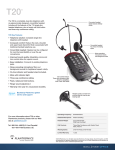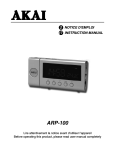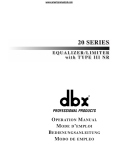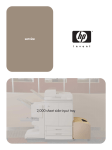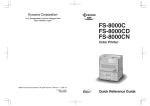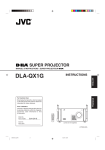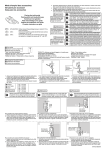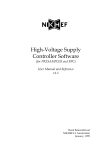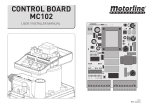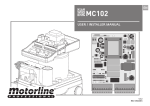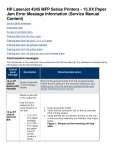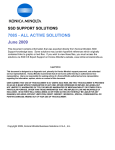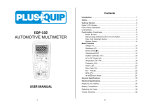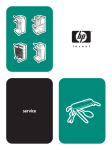Download Di850 Service Manual
Transcript
Service Manual [Field Service] Di850 Copyright 2002 MINOLTA CO., LTD. Use of this manual should be strictly supervised to avoid disclosure of confidential information. MINOLTA Co.,Ltd. 7662-4027-11 02080000 Service Manual [Field Service] Di850 SUBCOVER.FM Page 1 Friday, October 4, 2002 2:17 PM Dual references may be used on the following: Official Options name : Popular Options name EDH-5 : RADF C-403/C-404 FN-115 FN-7 Cover Inserter C : : : : LT and LCT FNS FNS PI PK-3 TMG-2 ZK-2 In-System Writer : PU TU PZ ISW : : DANGER, WARNING, AND CAUTION SYMBOLS AND EXPRESSIONS . .S-1 SAFETY WARNINGS . . . . . . . . . . . . . . . . . . S-2 SAFETY INFORMATION . . . . . . . . . . . . . . . . . S-9 IMPORTANT INFORMATION SAFETY CIRCUITS EXTERNAL SECTION........................................... 1-A-1 [1] Replacing Ozone Filters ......................... 1-A-1 [2] Removing and Reinstalling the External Cover.................................. 1-A-1 [3] Removing and Reinstalling the Front Right Door ............................... 1-A-2 [4] Removing and Reinstalling the Front Left Door ................................. 1-A-3 [5] Removing and Reinstalling the Operation Panel ............................... 1-A-3 . . . . . . . . . . . . . . . . . S-1 . . . . . . . . . . . S-9 DRIVE SECTION................................................... 1-B-1 [1] Removing and Reinstalling the Drum Motor ...................................... 1-B-1 [2] Removing and Reinstalling the Main Motor ....................................... 1-B-2 . . . . . . . . . . . . . . . . . . .S-10 INDICATION OF WARNING ON THE MACHINE . . .S-12 READ SECTION....................................................1-C-1 [1] Screw that Must not be Removed/ Loosened................................................1-C-1 [2] Removing and Reinstalling the CCD Unit ..........................................1-C-1 [3] Replacing the Exposure Lamp ...............1-C-3 [4] Replacing and Reinstalling the Exposure Unit...................................1-C-4 [5] Installing the Optics Wire........................1-C-5 [6] Cleaning the Slit Glass and White Color Reference Plate Glass..................1-C-8 [7] Cleaning the Platen Glass......................1-C-8 WRITE SECTION ..................................................1-D-1 [1] Removing and Reinstalling the Write Unit..........................................1-D-1 [2] Cleaning the Dust-proof Glass ...............1-D-2 [3] Removing and Reinstalling the Image Control Board .........................................1-D-3 DRUM UNIT........................................................... 1-E-1 [1] Removing and Reinstalling the Drum Unit ......................................... 1-E-1 [2] Cleaning and Installing the Coupling...... 1-E-2 [3] Removing and Reinstalling the Drum Temperature Sensor Board .... 1-E-2 [4] Cleaning the Toner Control Sensor Board...................................................... 1-E-3 [5] Removing, Cleaning and Reinstalling the Drum................................................. 1-E-4 [6] Removing and Reinstalling the Separation Claws ............................. 1-E-5 CORONA UNIT SECTION..................................... 1-F-1 [1] Screws that Must not be Removed/ Loosened................................................ 1-F-1 [2] Removing and Reinstalling the Charging Corona Unit....................... 1-F-1 [3] Removing and Reinstalling the Charge Control Plate........................ 1-F-2 [4] Replacing the Charging Wires................ 1-F-2 1-1 3 2DIS./ASSEMBLY ADJUSTMEN IMPORTANT NOTICE 3 DIS./ASSEMBLY 3 SERVICE 1. DISASSEMBLY/ASSEMBLY SAFETY AND IMPORTANT WARNING ITEMS . . . . S-1 4 ELECTRIC 3 DIS./ASSEMBLY PARTS LIST CONTENTS 3 DIS./ASSEMBLY 5 ISW CONTENTS 3 DIS./ASSEMBLY 1 FieldServiceTOC.fm Page 1 Thursday, October 10, 2002 11:05 AM 3 DIS./ASSEMBLY 1 FieldServiceTOC.fm Page 2 Thursday, October 10, 2002 11:05 AM CONTENTS [5] [6] [7] 3 DIS./ASSEMBLY 5 ISW 4 ELECTRIC 3 DIS./ASSEMBLY PARTS LIST 3 DIS./ASSEMBLY 3 SERVICE 3 2DIS./ASSEMBLY ADJUSTMEN [8] [9] [10] [11] [8] Removing and Reinstalling the Charging Wire Cleaning Pad ............ 1-F-3 Removing and Reinstalling the PCL....... 1-F-3 Cleaning the Charging Corona Unit/PCL ................................................. 1-F-4 Removing and Reinstalling the Transfer/ Separation Corona Unit .......................... 1-F-4 Removing and Reinstalling the Plunger Prevention Plate.................. 1-F-5 Replacing the Transfer/Separation Wires, Transfer/Separation Wire Cleaning Block and Support Rubbers.................... 1-F-5 Removing and Reinstalling the TSL Unit............................................ 1-F-7 [9] Removing and Reinstalling the Up/ Down Unit................................................1-J-6 Replacing the Up/Down Plate Wires .......1-J-7 TRAY 3 PAPER FEED UNIT................................. 1-K-1 [1] Removing and Reinstalling the Paper Feed Tray 3 ........................... 1-K-1 [2] Removing and Reinstalling the Front Cover of Paper Tray 3 ............................ 1-K-1 [3] Cleaning the Paper Dust Removing Brush...................................................... 1-K-2 [4] Cleaning the Paper Pre-registration PS/the Paper Feed PS........................... 1-K-2 [5] Removing and Reinstalling the Paper Feed Roller and the Feed Roller ............ 1-K-3 [6] Removing and Reinstalling the Double Feed Prevention Roller .......................... 1-K-4 [7] Replacing the Pre-registration MC3 (MC8) and the Feed MC3 (MC7) ... 1-K-5 [8] Removing and Reinstalling the Up/ Down Unit............................................... 1-K-6 [9] Replacing the Up/Down Plate Wires ...... 1-K-7 DEVELOPING UNIT ............................................. 1-G-1 [1] Screws that must not be Removed/ Loosened............................................... 1-G-1 [2] Removing and Reinstalling the Developing Unit ............................... 1-G-1 [3] Replacing the Developer ....................... 1-G-2 [4] Removing and Reinstalling the Developing Suction Filter................. 1-G-4 TONER SUPPLY UNIT..........................................1-H-1 [1] Replacing and Cleaning the Toner Cartridge ................................1-H-1 [2] Drawing out the Toner Supply Unit.........1-H-1 [3] Removing and Reinstalling the Toner Supply Sleeves 1 and 2 .........1-H-2 [4] Removing and Reinstalling the Toner Supply Unit.............................1-H-3 BY-PASS TRAY .....................................................1-L-1 [1] Removing and Reinstalling the By-pass Tray .....................................1-L-1 [2] Cleaning the Paper Size Detection Sensors ...................................................1-L-1 [3] Replacing the Paper Feed Roller/ the Feed Roller Rubbers .........................1-L-2 [4] Replacing the Double Feed Prevention Roller Rubber........................1-L-2 CLEANING/TONER RECYCLE UNIT .................... 1-I-1 [1] Removing and Reinstalling the Cleaning/Toner Recycle Unit................... 1-I-1 [2] Cleaning the Cleaning/Toner Recycle Unit ............................................ 1-I-2 [3] Removing and Reinstalling the Cleaning Blade .................................. 1-I-2 [4] Removing and Reinstalling the Toner Guide Brush and Plunger Prevention Felt ........................................ 1-I-4 [5] Replacing Guide Plate Assembly ............ 1-I-6 VERTICAL CONVEYANCE SECTION..................1-M-1 [1] Removing and Reinstalling the Vertical Conveyance Section .................1-M-1 [2] Removing and Reinstalling the Vertical Conveyance MC (MC9, MC10) ..............1-M-1 [3] Replacing the Vertical Conveyance Roller (Upper).........................................1-M-2 [4] Removing and Reinstalling the Vertical Conveyance Rollers (Middle/Lower) .....1-M-2 [5] Cleaning the Vertical Conveyance PS/Loop PS............................................1-M-3 PAPER FEED UNITS OF TRAYS 1 AND 2........... 1-J-1 [1] Removing and Reinstalling Paper Feed Trays 1 and 2.......................................... 1-J-1 [2] Removing and Reinstalling the Front Covers of Trays 1 and 2 ......................... 1-J-1 [3] Cleaning the Paper Dust Removing Brush ...................................................... 1-J-2 [4] Cleaning the Paper Pre-registration PS/Paper Feed PS ................................. 1-J-2 [5] Removing and Reinstalling the Paper Feed Roller and the Feed Roller ............ 1-J-3 [6] Removing and Reinstalling the Double Feed Prevention Roller........................... 1-J-4 [7] Replacing the Pre-registration and the Feed Clutches (MCs)........................ 1-J-5 ADU UNIT.............................................................. 1-N-1 [1] Drawing out and Reinstalling the ADU Stand ....................................... 1-N-1 [2] Cleaning the Paper Dust Removing Brush for Registration Roller .................. 1-N-1 [3] Cleaning the Paper Dust Removing Brushes for the Registration Roller ........ 1-N-2 [4] Cleaning PS44 (Registration PS) ........... 1-N-2 [5] Cleaning Paper Mis-centering PS (PS1)/ Leading Edge Detection PS (PS45) ....... 1-N-3 [6] Cleaning Paper Reverse PS (PS57)/ ADU Deceleration PS (PS59) ................ 1-N-3 [7] Removing and Reinstalling the ADU Cover ....................................... 1-N-4 1-2 [11] [12] [13] [14] [15] [16] [17] [18] [19] [20] [21] [22] [14] [15] [16] < RADF > EXTERNAL SECTION........................................... 1-P-1 [1] Removing the RADF .............................. 1-P-1 [2] Reinstalling the RADF ............................ 1-P-2 ORIGINAL FEED/CONVEYANCE/EXIT SECTION............................................................... 1-P-4 [1] Replacing the Pickup Roller and Conveyance Roller Rubber .................... 1-P-4 [2] Cleaning the Cleaning Pad..................... 1-P-5 [3] Replacing the Original Feed Roller/ Separation Roller/Auxiliary Separation Roller ...................................................... 1-P-5 [4] Cleaning the Paper Separation Rubber.................................................... 1-P-7 [5] Replacing the Double Feed Prevention Roller/Torque Limiter.............................. 1-P-7 [6] Cleaning Photo Sensors/Mirrors for Photo Sensors........................................ 1-P-8 < LCT > PAPER FEED SECTION .......................................1-Q-1 [1] Cleaning the Paper Dust Removing Brush ......................................................1-Q-1 [2] Cleaning the LT feed PS (PS106)/ LT first paper feed PS(PS107) ...............1-Q-1 [3] Removing and Reinstalling the Paper Feed Roller Unit...........................1-Q-2 [4] Replacing the Paper Feed Roller Rubber/ Feed Roller Rubber ................................1-Q-2 [5] Replacing the Double Feed Prevention Roller Rubber .......................1-Q-3 [6] Replacing the LT feed MC (MC101)/ LT first paper feed MC (MC102).............1-Q-5 [7] Replacing the C-403 Up/Down Wires.....1-Q-6 [8] Replacing the C-404 Up/Down Wires...1-Q-10 FIXING UNIT......................................................... 1-O-1 [1] Removing and Reinstalling the Fixing Unit........................................ 1-O-1 [2] Removing and Reinstalling the Fixing Unit Top Cover ...................... 1-O-1 [3] Replacing the Cleaning Web ................. 1-O-2 [4] Replacing the Fixing Heater Lamps (Upper/Roller) (L2, L3)........................... 1-O-3 [5] Removing and Reinstalling the Fixing Upper Roller .......................................... 1-O-4 [6] Removing and Reinstalling the Fixing Lower Roller .......................................... 1-O-4 [7] Removing and Reinstalling the Fixing Heat Roller Assembly.................. 1-O-5 [8] Replacing the Heater Lamp (Heat roller) (L4) .................................... 1-O-6 [9] Removing and Reinstalling the Fixing Heat Roller............................................. 1-O-7 [10] Removing and Reinstalling the Fixing Separation Claws (Lower)..... 1-O-7 [11] Removing and Reinstalling the Fixing Separation Claws (Upper)..... 1-O-8 1-3 3 2DIS./ASSEMBLY ADJUSTMEN [10] [13] Removing and Reinstalling the Actuator for Fixing Exit PS (PS2) .....1-O-8 Removing and Reinstalling Fixing Temperature Sensors 1 and 2 .....1-O-9 Removing and Reinstalling Fixing Temperature Sensors 3 and 4 ...1-O-10 Removing and Reinstalling the Thermostat (Upper) ........................1-O-12 Removing and Reinstalling the Thermostat (Lower) ........................1-O-14 3 DIS./ASSEMBLY 3 SERVICE [9] [12] Removing and Reinstalling Registration MC (MC1) .......................... 1-N-5 Removing and Reinstalling ADU Pre-registration MC (MC2)..................... 1-N-6 Removing and Reinstalling the Second Paper Feed Unit ................. 1-N-6 Removing and Reinstalling the ADU Stand....................................... 1-N-7 Removing and Reinstalling the Registration Roller .......................... 1-N-9 Removing and Reinstalling the Registration Motor (M12) Assembly .... 1-N-10 Removing and Reinstalling the Loop Roller, ADU Paper Exit Roller, and Pre-registration Roller.......................... 1-N-11 Removing and Reinstalling the Pre-transfer Roller and Pre-registration Loop Roller................. 1-N-13 Removing and Reinstalling the ADU Reverse Roller ...................... 1-N-15 Removing and Reinstalling the ADU Stand Drive Board Assembly ...... 1-N-17 Removing and Reinstalling the ADU Horizontal Conveyance Rollers 1 and 2 .................................... 1-N-18 Removing and Reinstalling the Paper Reverse/Exit Rollers 1, 2, and 3 .......... 1-N-20 Removing and Reinstalling the Paper Reverse/Exit Unit Entrance Roller ....... 1-N-22 Removing and Reinstalling the Paper Reverse/Exit Switchover Gate ............. 1-N-23 Removing and Reinstalling the Paper Exit Roller............................ 1-N-25 4 ELECTRIC 3 DIS./ASSEMBLY PARTS LIST [8] 3 DIS./ASSEMBLY 5 ISW CONTENTS 3 DIS./ASSEMBLY 1 FieldServiceTOC.fm Page 3 Thursday, October 10, 2002 11:05 AM 3 DIS./ASSEMBLY 5 ISW 4 ELECTRIC 3 DIS./ASSEMBLY PARTS LIST 3 DIS./ASSEMBLY 3 SERVICE 3 2DIS./ASSEMBLY ADJUSTMEN 3 DIS./ASSEMBLY 1 FieldServiceTOC.fm Page 4 Thursday, October 10, 2002 11:05 AM CONTENTS < FN > < PU > EXTERNAL SECTION...........................................1-R-1 [1] Removing and Reinstalling the Rear Cover .............................................1-R-1 [2] Removing and Reinstalling the Front Cover.............................................1-R-1 [3] Removing and Reinstalling the Top Cover...............................................1-R-1 [4] Removing and Reinstalling the Paper Exit Cover ....................................1-R-2 [5] Removing and Reinstalling the Main Tray................................................1-R-2 [6] Removing and Reattaching the Front Side Cover ....................................1-R-3 [7] Removing and Reinstalling the Paper Exit Stopper Plate ........................1-R-3 EXTERNAL SECTION........................................... 1-T-1 [1] Removing the PU (Puncher) ................. 1-T-1 PUNCH SECTION................................................. 1-T-2 [1] Replacing the Punch unit ....................... 1-T-2 [2] Replacing the Punch Clutch (MC1) ........ 1-T-3 PUNCH SCRAPS CONVEYANCE SECTION....... 1-T-4 [1] Replacing the Punch Scraps Conveyance motor (M7)......................... 1-T-4 < PZ > EXTERNAL SECTION........................................... 1-U-1 [1] Removing the PZ .................................. 1-U-1 PUNCH SECTION................................................. 1-U-2 [1] Replacing the Punch unit ....................... 1-U-2 [2] Replacing the Punch Clutch (MC1) ........ 1-U-3 PAPER FEED UNIT...............................................1-R-5 [1] Replacing a Paper Exit Roller (Sponge Roller) ......................................1-R-5 [2] Removing and Reinstalling the Paper Exit Unit/Shift Unit ........................1-R-5 [3] Removing and Reinstalling the Stacker/Stapler Unit................................1-R-8 PUNCH SCRAPS CONVEYANCE SECTION....... 1-U-4 [1] Replacing the Punch Scraps Conveyance motor (M7)......................... 1-U-4 Z-FOLDING SECTION .......................................... 1-U-5 [1] Removing and Installing the Z-folding/ Conveyance Unit.................................... 1-U-5 STAPLER UNIT ...................................................1-R-10 [1] Exchanging the clincher (FN-7 only)............................................1-R-10 [2] Removing and Reinstalling a Stapler (For FN-115).........................................1-R-11 [3] Removing and Reinstalling a Stapler (For FN-7).............................................1-R-12 < TU > TRIMMER SECTION............................................. 1-V-1 [1] Replacing the Upper and Lower Knives .................................................... 1-V-1 MAIN TRAY SECTION ........................................1-R-13 [1] Removing and Reinstalling the Up-Down Stay ......................................1-R-13 [2] Exchanging the Up-Down Wire ...........1-R-13 FOLDING UNIT (FN-7 ONLY) .............................1-R-15 [1] Removing and Reinstalling the Folding Unit ..........................................1-R-15 [2] Removing and Reinstalling the Adjustment Cover ................................1-R-16 < PI > PAPER FEED UNIT............................................... 1-S-1 [1] Replacing the Paper feed roller and Feed roller .............................................. 1-S-1 [2] Replacing the Double-feed prevention roller........................................................ 1-S-3 1-4 47 MODE .................................................................2-87 [1] 47 Mode / Multi Mode Setting Method......2-87 [2] Adjustment Data Display ..........................2-89 [3] Hard Disk Check ......................................2-89 [4] Input checklist...........................................2-90 [5] Output checklist........................................2-95 LIST OF ADJUSTMENT ITEMS ............................... 2-2 LCD ADJUSTMENT.................................................. 2-4 [1] LCD Control Panel Adjustment.................. 2-4 [2] LCD Panel Contrast/Key Sound Adjustment................................................. 2-4 SETTINGS AND ADJUSTMENTS MADE WITH THE UTILITY FUNCTION......................................... 2-4 [1] Checking and Printing the Utility Function .......................................... 2-4 [2] Setting up the Utility Function ................... 2-4 OTHER ADJUSTMENT .........................................2-101 [1] Centering Adjustment.............................2-101 [2] Paper Feed Roller Load Adjustment ......2-104 [3] Paper up/down plate horizontal adjustment..............................................2-105 [4] Skew adjustment ....................................2-107 [5] Tray spring pressure adjustment............2-109 [6] Paper feed height (upper limit) adjustment .............................................2-111 [7] Pick-up release amount adjustment .......2-113 [8] EDH mounting position adjustment ........2-115 [9] EDH Skew adjustment ...........................2-116 [10] EDH paper skew adjustment..................2-117 [11] EDH Hinge Spring Pressure Adjustment ............................................2-118 [12] FNS Adjusting the Magnets on Conveyance Guide Plate B ....................2-119 [13] FNS Adjusting the Magnets on Conveyance Guide Plate C ....................2-120 [14] FNS Adjusting the Sub-tray Paper Exit Gate.................................................2-121 [15] FNS Adjusting the Paper-Path Switching Gate .......................................2-122 [16] FNS Adjusting the By-pass Gate............2-123 [17] FNS Adjusting the Shift Position ............2-124 [18] FNS Adjusting Opening/Closing at the Paper Exit.........................................2-125 [19] FNS Adjusting the Paper Exit-Opening Solenoid .................................................2-126 [20] FNS Adjusting the Paper Exit Opening Lower Guide Plate..................................2-127 [21] FNS Adjusting the Mount Location of the Paper Exit Arm .................................2-128 [22] FNS Adjusting the Mount Location of the Upper Alignment Plates....................2-128 [23] FNS Adjusting the Tension of the Upper Alignment Plate Drive Timing Belt..........2-129 [24] FNS Adjusting the Mount Location of the Lower Alignment Plates (FN-7 only).......2-130 [25] FNS Adjusting the Tension of the Lower Alignment Plate Drive Timing Belt (FN-7 only) .............................................2-131 [26] FNS Adjusting the Stapling Position (Flat Stapling) .........................................2-131 MODE CHANGING MENU ....................................... 2-5 [1] Mode Selection .......................................... 2-5 [2] Display transition of 36 modes................... 2-6 [3] Display transition of 25 modes................... 2-7 [4] Display transition of Key Operation modes ........................................................ 2-7 25 MODE .................................................................. 2-8 [1] Setting the 25 Mode .................................. 2-8 [2] Setting Software DIP Switches .................. 2-8 [3] Setting the Paper Size ............................. 2-22 [4] PM Count Resetting ................................ 2-23 5] Setting the PM Cycle ............................... 2-24 [6] Collecting Data ........................................ 2-24 [7] Copy Count by Parts to be Replaced (Fixed Parts) ............................................ 2-40 [8] Copy Count by Parts to be Replaced (Optional Parts) ....................................... 2-44 [9] Setting Passwords ................................... 2-45 [10] Setting the Telephone Number and/or Fax Number of the Service Center .......... 2-46 [11] Setting the Serial Number........................ 2-47 [12] Displaying the ROM Version.................... 2-47 [13] List of Adjustment Items for 25 Mode ...... 2-48 36 MODE ................................................................ 2-49 [1] Setting Method ........................................ 2-49 [2] High Voltage Adjustment ......................... 2-49 [3] Drum Peculiarity Adjustment ................... 2-51 [4] Drum Peculiarity Adjustment (Manual) .... 2-57 [5] User Paper Setting .................................. 2-57 [6] Recall Standard Data (Process Adjustment) .............................. 2-58 [7] Tray Adjustment ...................................... 2-58 [8] Magnification Adjustment......................... 2-59 [9] Timing Adjustment ................................... 2-62 [10] EDH Adjustment ...................................... 2-66 [11] Centering Adjustment .............................. 2-68 [12] Distortion adjustment (Copier) ................. 2-70 [13] Non-image area erase check................... 2-71 [14] Recall standard data 1-5 3 2DIS./ASSEMBLY ADJUSTMEN ADJUSTMENTS MADE WHEN REPLACING PARTS ...................................................................... 2-1 [1] [How to Read Tables] ................................ 2-1 (Image adjustment) .................................2-72 Running Test Mode ..................................2-72 Test pattern output mode .........................2-73 Test pattern density setting ......................2-80 Finisher adjustment ..................................2-80 List Output Mode ......................................2-86 3 DIS./ASSEMBLY 3 SERVICE [15] [16] [17] [18] [19] HOW TO USE THIS SECTION................................. 2-1 [1] Scope and Precautions ............................. 2-1 4 ELECTRIC 3 DIS./ASSEMBLY PARTS LIST 2. ADJUSTMENT 3 DIS./ASSEMBLY 5 ISW CONTENTS 3 DIS./ASSEMBLY 1 FieldServiceTOC.fm Page 5 Thursday, October 10, 2002 11:05 AM 3 DIS./ASSEMBLY 1 FieldServiceTOC.fm Page 6 Thursday, October 10, 2002 11:05 AM CONTENTS [27] [28] 3 2DIS./ASSEMBLY ADJUSTMEN [29] [30] [31] [32] [33] 3 DIS./ASSEMBLY 3 SERVICE [34] [35] [36] [37] [38] [39] 4. ELECTRIC PARTS LIST FNS Adjusting the Stapler Vertical Positioning (FN-7 only) .......................... 2-132 FNS Adjusting the Angle of the Stapling Stopper (FN-7 only) ............................... 2-134 FNS Adjusting the Angle of the Folding Stopper (FN-7 only) ............................... 2-135 FNS Adjusting the Tension of the Stapler Movement Timing Belt (FN-7 only)........ 2-136 FNS Adjusting the Tension of the Stapler Rotation Timing Belt (FN-7 only) ........... 2-136 FNS Adjusting the Folding Force (FN-7 only)............................................. 2-137 FNS Adjusting the Mount Location of the Folding Knife Motor (FN-7 only) ............ 2-137 TU Trimming Parallelism Adjustment .... 2-138 Adjusting the PZ Paper-Path Switching Solenoid ................................................ 2-138 Adjusting the Tension of the PZ Punch Shift Timing Belt ................................... 2-140 Adjusting the 1st Folding Skew ............. 2-140 Adjusting the Position of the 2nd Folding Stopper .................................................. 2-142 Adjusting the 2nd Folding Skew 2nd Stopper Assembly ................................. 2-143 Parts Layout Drawing ................................................4-1 [1] Di850 Parts Layout Drawing ......................4-1 [2] EDH-5 Parts Layout Drawing .....................4-9 [3] C-403/C-404 Parts Layout Drawing .........4-10 [4] FN-7/FN-115 Parts Layout Drawing .........4-11 [5] TMG-2 Parts Layout Drawing...................4-14 [6] PK-3 Parts Layout Drawing......................4-15 [7] ZK-2 Parts Layout Drawing ......................4-16 [8] Cover Inserter C Parts Layout Drawing ...4-17 Connector Layout Drawing ......................................4-18 [1] Di850 Connector Layout Drawing ............4-18 [2] EDH-5 Connector Layout Drawing...........4-31 [3] C-403/C-404 Connector Layout Drawing ....................................................4-32 [4] FN-7/FN-115 Connector Layout Drawing ....................................................4-33 [5] Cover Inserter C Connector Layout Drawing ....................................................4-33 [6] PK-3 Connector Layout Drawing..............4-34 [7] ZK-2 Connector Layout Drawing ..............4-35 [8] TMG-2 Connector Layout Drawing ..........4-36 Jam Code List..........................................................4-37 Error Code List ........................................................4-49 Timing chart.............................................................4-86 [1] Di850 Timing Chart .................................4-86 [2] EDH-5 Timing Chart (1) ...........................4-87 [3] EDH-5 Timing Chart (2) ...........................4-88 [4] C-403/C-404 Timing Chart .......................4-89 [5] FN-7/FN-115 TIming Chart (1) .................4-90 [6] FN-7/FN-115 Timing Chart (2) .................4-91 [7] FN-7/FN-115 Timing Chart (3) .................4-92 [8] PK-3 Timing Chart (1) ..............................4-93 [9] PK-3 Timing Chart (2) ..............................4-94 [10] ZK-2 Timing Chart ...................................4-95 [11] TMG-2 Timing Chart (1) ...........................4-96 [12] TMG-2 Timing Chart (2) ...........................4-97 3 DIS./ASSEMBLY 5 ISW 4 ELECTRIC 3 DIS./ASSEMBLY PARTS LIST 3. SERVICE SERVICE SCHEDULE ............................................. 3-1 [1] Service Schedule....................................... 3-1 [2] Maintenance Items .................................... 3-3 [3] Main Body Periodic Inspection Items ...... 3-10 [4] RADF [EDH-5] ......................................... 3-13 [5] FNS [FN-115] .......................................... 3-14 [6] FNS [FN-7] ............................................. 3-14 [7] LCT [C-403/404] ..................................... 3-15 [8] PI [Cover Inserter C]................................ 3-15 [9] TU [TMG-2].............................................. 3-16 [10] PU [PK-3]................................................. 3-16 [11] PZ [ZK-2 .................................................. 3-16 [12] Replacement parts list ............................. 3-17 COPY MATERIALS ................................................ 3-22 [1] Single unit supply .................................... 3-22 SERVICE MATERIAL LIST .................................... 3-23 1-6 CONTENTS 5. ISW What's ISW? ............................................................. 5-1 3 DIS./ASSEMBLY 3 SERVICE 3 2DIS./ASSEMBLY ADJUSTMEN SETUP ...................................................................... 5-2 [1] ISW-compatible boards ............................. 5-2 [2] Data flow.................................................... 5-2 [3] Prepare the copier to start an ISW transfer ...................................................... 5-2 [4] HELP + CHECK mode operation flow ....... 5-4 [5] HELP + CHECK mode operating procedure .................................................. 5-5 [6] Error code table for ISW Setup.................. 5-8 [7] Preparing the copier to transfer ................. 5-9 [8] Relationships between processing states and operational LEDs ................... 5-10 [9] Rewriting procedure after an error interruption............................................... 5-10 [10] Connecting the ISW connector ................ 5-11 3 DIS./ASSEMBLY 1 FieldServiceTOC.fm Page 7 Thursday, October 10, 2002 11:05 AM UPDATING WITH ISW Trns ................................... 5-12 [1] Setting Up ISW Trns ................................ 5-12 [2] Copying Transfer Data (Update Data) ..... 5-17 [3] Connecting the Di850 .............................. 5-18 [4] Updating .................................................. 5-18 [5] ISW Trns Messages ................................ 5-23 [6] Troubleshooting ISW Trns ....................... 5-25 3 DIS./ASSEMBLY 5 ISW 4 ELECTRIC 3 DIS./ASSEMBLY PARTS LIST APPENDIX [1] Overall Wiring Diagram 1-7 3 DIS./ASSEMBLY 5 ISW 4 ELECTRIC 3 DIS./ASSEMBLY PARTS LIST 3 DIS./ASSEMBLY 3 SERVICE 3 2DIS./ASSEMBLY ADJUSTMEN 3 DIS./ASSEMBLY 1 FieldServiceTOC.fm Page 8 Thursday, October 10, 2002 11:05 AM SAFETY.FM Page 1 Friday, October 4, 2002 3:19 PM SAFETY AND IMPORTANT WARNING ITEMS SAFETY AND IMPORTANT WARNING ITEMS Read carefully the Safety and Important Warning Items described below to understand them before doing service work. IMPORTANT NOTICE Because of possible hazards to an inexperienced person servicing this copier as well as the risk of damage to the copier, Minolta Corporation strongly recommends that all servicing be performed only by Minolta-trained service technicians. Changes may have been made to this copier to improve its performance after this Service Manual was printed. Accordingly, Minolta Corporation does not warrant, either explicitly or implicitly, that the information contained in this Service Manual is complete and accurate. The user of this Service Manual must assume all risks of personal injury and/or damage to the copier while servicing the copier for which this Service Manual is intended. Therefore, this Service Manual must be carefully read before doing service work both in the course of technical training and even after that, for performing maintenance and control of the copier properly. Keep this Service Manual also for future service. DANGER, WARNING, AND CAUTION SYMBOLS AND EXPRESSIONS In this Service Manual, each of three expressions " DANGER," " WARNING," and " CAUTION" is defined as follows together with a symbol mark to be used in a limited meaning. When servicing the copier, the relevant works (disassembling, reassembling, adjustment, repair, maintenance, etc.) need to be conducted with utmost care. DANGER :Action having a high possibility of suffering death or serious injury WARNING :Action having a possibility of suffering death or serious injury CAUTION :Action having a possibility of suffering a slight wound, medium trouble, and property damage Symbols used for important warning items are defined as follows: :Precaution :Prohibition :Direction General precaution Electric shock Heated surface General prohibition Do not touch with wet hand Do not disassemble General instruction Unplug Ground/Earth S-1 SAFETY.FM Page 2 Friday, October 4, 2002 3:19 PM SAFETY AND IMPORTANT WARNING ITEMS SAFETY WARNINGS [1] MODIFICATIONS NOT AUTHORIZED BY MINOLTA Minolta copiers are renowned for their high reliability. This reliability is achieved through high-quality design and a solid service network. Copier design is a highly complicated and delicate process where numerous mechanical, physical, and electrical aspects have to be taken into consideration, with the aim of arriving at proper tolerances and safety factors. For this reason, unauthorized modifications involve a high risk of degradation in performance and safety. Such modifications are therefore strictly prohibited. the points listed below are not exhaustive, but they illustrate the reasoning behind this policy. PROHIBITED ACTIONS: • Using any cables or power cord not specified by Minolta. • Using any fuse or thermostat not specified by Minolta. Safety will not be assured, leading to a risk of fire and injury. • Disabling fuse functions or bridging fuse terminals with wire, metal clips, solder or similar object. • Disabling relay functions (such as wedging paper between relay contacts) • Disabling safety functions (interlocks, safety circuits, etc.) Safety will not be assured, leading to a risk of fire and injury. • Making any modification to the copier unless instructed by Minolta • Using parts not specified by Minolta S-2 SAFETY.FM Page 3 Friday, October 4, 2002 3:19 PM SAFETY AND IMPORTANT WARNING ITEMS [2] CHECKPOINTS WHEN PERFORMING ON-SITE SERVICE Minolta copiers are extensively tested before shipping, to ensure that all applicable safety standards are met, in order to protect the customer and customer engineer (hereafter called the CE) from the risk of injury. However, in daily use, any electrical equipment may be subject to parts wear and eventual failure. In order to maintain safety and reliability, the CE must perform regular safety checks. 1.Power Supply WARNING: Wall Outlet • Check that mains voltage is as specified. Plug the power cord into the dedicated wall outlet with a capacity greater than the maximum power consumption. If excessive current flows in the wall outlet, fire may result. • If two or more power cords can be plugged into the wall outlet, the total load must not exceed the rating of the wall outlet. If excessive current flows in the wall outlet, fire may result. WARNING: Power Plug and Cord • Make sure the power cord is plugged in the wall outlet securely. Contact problems may lead to increased resistance, overheating, and the risk of fire. • Check whether the power cord is damaged. Check whether the sheath is damaged. If the power plug, cord, or sheath is damaged, replace with a new power cord (with plugs on both ends) specified by Minolta. Using the damaged power cord may result in fire or electric shock. • When using the power cord (inlet type) that came with this copier, be sure to observe the following precautions: a. Make sure the copier-side power plug is securely inserted in the socket on the rear panel of the copier. Secure the cord with a fixture properly. b. If the power cord or sheath is damaged, replace with a new power cord (with plugs on both ends) specified by Minolta. If the power cord (inlet type) is not connected to the copier securely, a contact problem may lead to increased resistance, overheating, and risk of fire. • Check whether the power cord is not stepped on or pinched by a table and so on. Overheating may occur there, leading to a risk of fire. S-3 kw SAFETY.FM Page 4 Friday, October 4, 2002 3:19 PM SAFETY AND IMPORTANT WARNING ITEMS WARNING: Power Plug and Cord • Do not bundle or tie the power cord. Overheating may occur there, leading to a risk of fire. • Check whether dust is collected around the power plug and wall outlet. Using the power plug and wall outlet without removing dust may result in fire. • Do not insert the power plug into the wall outlet with a wet hand. The risk of electric shock exists. • When unplugging the power cord, grasp the plug, not the cable. The cable may be broken, leading to a risk of fire and electric shock. WARNING: Wiring • Never use multi-plug adapters to plug multiple power cords in the same outlet. If used, the risk of fire exists. • When an extension cord is required, use a specified one. Current that can flow in the extension cord is limited, so using a too long extension cord may result in fire. Do not use an extension cable reel with the cable taken up. Fire may result. WARNING: Ground Lead • Check whether the copier is grounded properly. If current leakage occurs in an ungrounded copier, you may suffer electric shock while operating the copier. Connect the ground lead to one of the following points: a. Ground terminal of wall outlet b. Ground terminal for which Class D work has been done S-4 SAFETY.FM Page 5 Friday, October 4, 2002 3:19 PM SAFETY AND IMPORTANT WARNING ITEMS WARNING: Ground Lead • Pay attention to the point to which the ground lead is connected. Connecting the ground lead to an improper point such as the points listed below results in a risk of explosion and electric shock: a. Gas pipe (A risk of explosion or fire exists.) b. Lightning rod (A risk of electric shock or fire exists.) c. Telephone line ground (A risk of electric shock or fire exists in the case of lightning.) d. Water pipe or faucet (It may include a plastic portion.) 2.Installation Requirements WARNING: Prohibited Installation Place • Do not place the copier near flammable materials such as curtains or volatile materials that may catch fire. A risk of fire exists. • Do not place the copier in a place exposed to water such as rain water. A risk of fire and electric shock exists. WARNING: Nonoperational Handling • When the copier is not used over an extended period of time (holidays, etc.), switch it off and unplug the power cord. Dust collected around the power plug and outlet may cause fire. CAUTION: Temperature and Humidity • Do not place the copier in a place exposed to direct sunlight or near a heat source such as a heater. A risk of degradation in copier performance or deformation exists. Do not place the copier in a place exposed to cool wind. Recommended temperature and humidity are as follows: Temperature: 10°C to 30°C 50°F to 86°F Humidity: 10% to 80% (no dew condensation) Avoid other environments as much as possible. CAUTION: Ventilation • Do not place the copier in a place where there is much dust, cigarette smoke, or ammonia gas. Place the copier in a well ventilated place to prevent machine problems and image faults. S-5 SAFETY.FM Page 6 Friday, October 4, 2002 3:19 PM SAFETY AND IMPORTANT WARNING ITEMS CAUTION: Ventilation • The copier generates ozone gas during operation, but it is not sufficient to be harmful to the human body. If a bad smell of ozone is present in the following cases, ventilate the room. a. When the copier is used in a poorly ventilated room b. When taking a lot of copies c. When using multiple copiers at the same time CAUTION: Vibration • When installing the copier, read the Installation Guide thoroughly. Be sure to install the copier in a level and sturdy place. Constant vibration will cause problems. • Be sure to lock the caster stoppers. In the case of an earthquake and so on, the copier may slide, leading to a injury. CAUTION: Inspection before Servicing • Before conducting an inspection, read all relevant documentation (Service Manual, technical notices, etc.) and proceed with the inspection following the prescribed procedure, using only the prescribed tools. Do not make any adjustment not described in the documentation. If the prescribed procedure or tool is not used, the copier may break and a risk of injury or fire exists. • Before conducting an inspection, be sure to disconnect the power plugs from the copier and options. When the power plug is inserted in the wall outlet, some units are still powered even if the POWER switch is turned OFF. A risk of electric shock exists. • The area around the fixing unit is hot. You may get burnt. DANGER: Work Performed with the Copier Powered • Take every care when making adjustments or performing an operation check with the copier powered. If you make adjustments or perform an operation check with the external cover detached, you may touch live or high-voltage parts or you may be caught in moving gears or the timing belt, leading to a risk of injury. S-6 SAFETY.FM Page 7 Friday, October 4, 2002 3:19 PM SAFETY AND IMPORTANT WARNING ITEMS DANGER: Work Performed with the Copier Powered • Take every care when servicing with the external cover detached. High-voltage exists around the drum unit. A risk of electric shock exists. WARNING: Safety Checkpoints • Check the exterior and frame for edges, burrs, and other damages. The user or CE may be injured. • Do not allow any metal parts such as clips, staples, and screws to fall into the copier. They can short internal circuits and cause electric shock or fire. • Check wiring for squeezing and any other damage. Current can leak, leading to a risk of electric shock or fire. • When disconnecting connectors, grasp the connector, not the cable. (Specifically, connectors of the AC line and high-voltage parts) Current can leak, leading to a risk of electric shock or fire. • Carefully remove all toner remnants and dust from electrical parts and electrode units such as a charging corona unit. Current can leak, leading to a risk of copier trouble or fire. • Check high-voltage cables and sheaths for any damage. Current can leak, leading to a risk of electric shock or fire. • Check electrode units such as a charging corona unit for deterioration and sign of leakage. Current can leak, leading to a risk of trouble or fire. • Before disassembling or adjusting the write unit incorporating a laser, make sure that the power cord has been disconnected. The laser light can enter your eye, leading to a risk of loss of eyesight. • Do not remove the cover of the write unit. Do not supply power with the write unit shifted from the specified mounting position. The laser light can enter your eye, leading to a risk of loss of eyesight. • When replacing a lithium battery, replace it with a new lithium battery specified in the Parts Guide Manual. Dispose of the used lithium battery using the method specified by local authority. Improper replacement can cause explosion. S-7 SAFETY.FM Page 8 Friday, October 4, 2002 3:19 PM SAFETY AND IMPORTANT WARNING ITEMS WARNING: Safety Checkpoints • After replacing a part to which AC voltage is applied (e.g., optical lamp and fixing lamp), be sure to check the installation state. A risk of fire exists. • Check the interlock switch and actuator for loosening and check whether the interlock functions properly. If the interlock does not function, you may receive an electric shock or be injured when you insert your hand in the copier (e.g., for clearing paper jam). • Make sure the wiring cannot come into contact with sharp edges, burrs, or other pointed parts. Current can leak, leading to a risk of electric shock or fire. • Make sure that all screws, components, wiring, connectors, etc. that were removed for safety check and maintenance have been reinstalled in the original location. (Pay special attention to forgotten connectors, pinched cables, forgotten screws, etc.) A risk of copier trouble, electric shock, and fire exists. HANDLING OF MATERIALS FOR SERVICING • Unplug the power cord from the wall outlet. Drum cleaner (isopropyl alcohol) and roller cleaner (acetone-based) are highly flammable and must be handled with care. A risk of fire exists. • Do not replace the cover or turn the copier ON before any solvent remnants on the cleaned parts have fully evaporated. A risk of fire exists. • Use only a small amount of cleaner at a time and take care not to spill any liquid. If this happens, immediately wipe it off. A risk of fire exists. • When using any solvent, ventilate the room well. Breathing large quantities of organic solvents can lead to discomfort. S-8 SAFETY.FM Page 9 Friday, October 4, 2002 3:19 PM SAFETY INFORMATION DANGER: HANDLING OF MATERIALS FOR SERVICING • Toner and developer are not harmful substances, but care must be taken not to breathe excessive amounts or let the substances come into contact with eyes, etc. It may be stimulative. If the substances get in the eye, rinse with plenty of water immediately. When symptoms are noticeable, consult a physician. • Never throw the used cartridge and toner into fire. You may be burned due to dust explosion. [3] CONCLUSION 1. Safety of users and customer engineers depends highly on accurate maintenance and administration. Therefore, safety can be maintained by the appropriate daily service work conducted by the customer engineer. 2. When performing service, each copier on the site must be tested for safety. The customer engineer must verify the safety of parts and ensure appropriate management of the equipment. SAFETY INFORMATION IMPORTANT INFORMATION The Center for Devices and Radiological Health (CDRH) of the U.S. Food and Drug Administration implemented regulations for laser products manufactured since August 1, 1976. Compliance is mandatory for products marketed in the United States. This copier is certified as a “Class 1” laser product under the U.S. Department of Health and Human Services (DHHS) Radiation Performance Standard according to the Radiation Control for Health and Safety Act of 1968. Since radiation emitted inside this copier is completely confined within protective housings and external covers, the laser beam cannot escape during any phase of normal user operation. S-9 SAFETY.FM Page 10 Friday, October 4, 2002 3:19 PM SAFETY INFORMATION SAFETY CIRCUITS [2] This machine is provided with the following safety circuits to prevent machine faults from resulting in seri- Protection by L2 and L4 (fixing heater lamps) overheating prevention circuit ous accidents. Overall protection circuit [2] L2 and L4 (fixing heater lamps) overheating prevention circuit RL1 CB TH3 These safety circuits are described below to provide the service engineer with a renewed awareness of RL driver section RL1 Control section TH2 them in order to prevent servicing errors that may impair their functions. Overall Protection Circuit TH1 [1] ACDB TH4 [1] TS1 AC driver section L2 L4 CBR1 1. NF Protection by software The output voltage from TH1 (fixing tempera- NF2 ture sensor 1) is read by the CPU. If this voltage is abnormal, L2 (fixing heater lamp 1), and L4 (fixing heater lamp 3), and RL1 (main relay) are turned OFF. 1. Protection by CBR1 (circuit breakers) CBR1 interrupt the AC line instantaneously when an excessive current flows due to a short CAUTION: Do not change the gap between the roller and TH1. When replacing TH1, check the in the AC line. specified mounting dimensions. The RL1 function must not be deactivated CAUTION: The CBR1 functions must not be deacti- under any circumstances. vated under any circumstances. S-10 SAFETY.FM Page 11 Friday, October 4, 2002 3:19 PM SAFETY INFORMATION 2. Protection by the hardware circuit The output voltages from TH1 and TH2 (fixing temperature sensor 2), TH3 (fixing temperature sensor 3), and TH4 (fixing temperature sensor 4) are compared with the abnormality judgement reference value in the comparator circuit. If the output voltage from TH1, TH2, TH3, or TH4 exceeds the reference value, L2, L4, and RL1 are turned off in hardware means. CAUTION: Periodically check the TH2 and TH4 faces contacting the roller, and replace TH2 and/or TH4 if any abnormality is detected. Do not change the gap between the roller and each sensor TH2 and TH4. When replacing TH2 or TH4, check the specified mounting dimensions. The RL1 function must not be deactivated under any circumstances. 3. Protection by TS1 (thermostat (upper)) and TS2 (thermostat (lower)) TS1 is turned off when the temperature of the fixing roller (upper) exceeds the specified value, and TS2 is turned off when the temperature of the heating (upper) roller exceeds the specified value, thus interrupting the power to L2 and L4 directly. CAUTION: Do not use any other electrical conductor in place of TS1 and TS2. S-11 SAFETY.FM Page 12 Friday, October 4, 2002 3:19 PM SAFETY INFORMATION INDICATION OF WARNING ON THE MACHINE Caution labels shown below are attached in some areas on/in the machine areas. When accessing these areas for maintenance, repair, or adjustment, special care should be taken to avoid burns and shock hazards. CAUTION ATTENTION VORSICHT PRECAUCION ATTENZIONE WARNING DANGER WARNUNG ADVERTENCIA (Both sides of the fixing unit) CAUTION ATTENTION VORSICHT PRECAUCION ATTENZIONE 2 2 AVVERTIMENTO CAUTION WARNING This area generates high voltage. If touched, electrical shock may occur. DO NOT TOUCH! The fixing unit is very hot. To avoid getting burned DO NOT TOUCH. 1 (Top surface of the fixing unit) (Inside of the fixing unit) (Front side of the fixing unit) CAUTION CAUTION CAUTION ATTENTION VORSICHT PRECAUCION ATTENZIONE The conveyance fixing unit is heavy. Use care and draw it out gently; otherwise you may be injured. ATTENTION VORSICHT CAUTION PRECAUCION ATTENZIONE DO NOT put your hand between the main body and developing fixing unit; otherwise you may be injured. CAUTION Please adhere to all caution labels to avoid burns or injury. S-12 SAFETY.FM Page 13 Friday, October 4, 2002 3:19 PM SAFETY INFORMATION PS WARNING Unplug the machine before removing platen glass. DANGER Debrancher le copieur avant de retirer la vitre d'exposition. WARNUNG Vor Entfernen des Vorlagenglases Netzstecker ziehen. ADVERTENCIA Desenchufe la maquina antes de quitar el vidrio. AVVERTIMENTO Estrarre la spina dalla presa prima di rimuovere il vetro di esposizione. PS Elektrische Teile In dieser Einheit DANGER VISIBLE LASER RADIATION WHEN OPEN. AVOID DIRECT EXPOSURE TO BEAM. PS for BA standard PS VISIBLE LASER RADIATION WHEN OPEN. AVOID DIRECT EXPOSURE TO BEAM LASERSTRAHLUNG,WENN ABDECKUNG GEÖFFNET. NICHT DEM STRAHL AUSSETZEN. CAUTION Please adhere to all caution labels to avoid burns or injury. S-13 RAYON LASER VISIBLE LORS DE L‘OUVERTURE. EVITER L‘EXPOSITION DERECTE. SAFETY.FM Page 14 Friday, October 4, 2002 3:19 PM SAFETY INFORMATION Tray 1 Tray 2 CAUTION CAUTION DO NOT put your hand between the main body and tray; otherwise you may be injured. Tray 3 FN-7 Only CAUTION ATTENTION PRECAUCION CUIDADO CAUTION ATTENTION VORSICHT PRECAUCION ATTENZIONE CAUTION Use care after opening the paper exit outlet. DO NOT put your hands into the paper exit outlet as you may be injured. CAUTION Inside the lower paper exit outlet is the roller drive unit. DO NOT put your hands into the paper exit outlet as you may be injured Finisher [FN-7 / FN-115] CAUTION Please adhere to all caution labels to avoid burns or injury. S-14 SAFETY.FM Page 15 Friday, October 4, 2002 3:19 PM SAFETY INFORMATION CAUTION WARNING WARNING Unplug the machine before removing panels. D brancher lÕappareil avant de retirer les panneaux arri res. Desenchufe la m‡quina antes de quitar los paneles. Desconecte a unidade da tomada antes de remover os pain is. Unplug the machine before removing panels. D brancher lÕappareil avant de retirer les panneaux arri res. Vor Abnahme der Schutzverkleidung Netzstecker ziehen. Desenchufe la m‡quina antes de quitar los paneles. Scollegare la macchina prima di rimuovere i pannelli. Trimmer [TMG-2] CAUTION Please adhere to all caution labels to avoid burns or injury. S-15 SAFETY.FM Page 16 Friday, October 4, 2002 3:19 PM SAFETY INFORMATION WARNING Unplug the machine before removing panels. Débrancher l’appareil avant de retirer les panneaux arrières. Desenchufe la máquina antes de quitar los paneles. Desconecte a unidade da tomada antes de remover os painéis. Unplug the machine before removing panels. Débrancher l’appareil avant de retirer les panneaux arrières. Vor Abnahme der Schutzverkleidung Netzstecker ziehen. Desenchufe la máquina antes de quitar los paneles. Scollegare la macchina prima di rimuovere i pannelli. <PK-3 Puncher> <ZK-2 Puncher with Z-folding> CAUTION Please adhere to all caution labels to avoid burns or injury. S-16



























